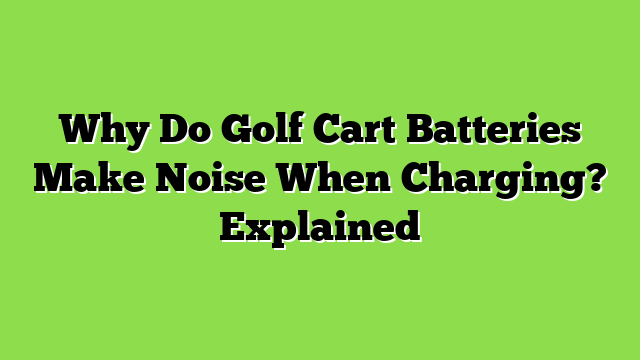If you own a golf cart, you may have experienced a loud, buzzing noise coming from the batteries while charging. This can be concerning, especially if you are not sure what is causing the noise. In this article, we will explain why golf cart batteries make noise when charging and what you can do to mitigate it.
Key Takeaways:
- The noise produced during golf cart battery charging is a normal part of the process.
- The charging process involves different stages, each of which may produce noise.
- Common issues such as loose connections and corroded terminals can contribute to the noise.
- Maintaining and properly caring for the batteries can help minimize noise during charging.
- Older batteries may produce more noise during charging and may need to be replaced.
The Charging Process of Golf Cart Batteries
To understand why golf cart batteries make noise during charging, it’s essential to comprehend the charging process. Golf cart batteries use lead-acid technology, which means they require a specific charging cycle to maintain their optimal performance. The charging process consists of three stages: bulk, absorption, and float.
The first stage, bulk charging, involves the initial charging of the batteries at a high rate of current. This stage aims to charge the batteries quickly and efficiently by delivering a high amount of power. During this stage, the charging voltage can range from 14.8 to 15.5 volts, depending on the battery’s capacity and the charger’s specifications.
The second stage, absorption charging, is when the charger delivers a lower level of current, and the voltage remains constant. This stage aims to charge the battery to its full capacity and prevent overcharging. During this stage, the charging voltage typically ranges from 14.2 to 14.8 volts.
The final stage, float charging, involves maintaining the battery’s full charge without overcharging it. During this stage, the charger uses a low level of current and voltage to keep the battery fully charged while minimizing its stress. The charging voltage during this stage usually ranges from 13.2 to 13.6 volts.
Factors Contributing to Charging Noise in Golf Cart Batteries
The charging process can generate noise due to various factors, such as the charger’s design and the battery’s condition. Inadequate ventilation, low-quality battery chargers, or faulty components can also contribute to charging noise.
Low-quality battery chargers may produce electrical noise that gets amplified by the battery during charging, resulting in noise. Faulty components, such as corroded terminals or loose connections, can also generate extra heat and noise during charging.
| Factor | Possible Causes |
|---|---|
| Charger design | Low-quality charger, Inadequate ventilation |
| Battery condition | Age, Wear and tear, Water level, Dirt and debris |
| Faulty components | Corroded terminals, Loose connections, Damaged wiring |
Understanding the charging process and the factors contributing to charging noise can help you troubleshoot and resolve the issue. In the next section, we’ll explore the common issues that can cause noise during golf cart battery charging.
Common Issues Causing Noise in Golf Cart Battery Charging
While golf cart batteries can produce noise during charging under normal circumstances, excessive noise may be an indication of underlying issues. Here are some common issues that can cause noisy golf cart battery charging.
| Issue | Description |
|---|---|
| Loose Connections | Loose or corroded battery connections can cause resistance and generate heat, leading to increased noise during charging. |
| Faulty Charger | A faulty or damaged charger can cause the batteries to overcharge, leading to excessive noise and potential damage to the batteries. |
| Corroded or Damaged Terminals | Corroded or damaged battery terminals can cause inconsistent charging, leading to increased noise and potential damage to the batteries. |
| Worn-Out Battery Components | Old and worn-out battery components such as plates or separators can cause increased resistance and noise during charging. |
| Overheating | If the batteries or charger become too hot during charging, it can lead to increased noise and potential damage. |
It is essential to address these issues promptly to prevent further damage to the batteries and reduce noise during charging.
Troubleshooting Golf Cart Battery Charging Noise
If you’re experiencing noise during golf cart battery charging, there are steps you can take to troubleshoot and resolve the issue. Here are some common issues and solutions:
| Issue | Solution |
|---|---|
| Loose connections | Check all battery connections and tighten any loose connections. |
| Corroded terminals | Clean the battery terminals with a terminal cleaner and apply a terminal protectant. |
| Faulty components | Check the battery charger and replace any faulty components. |
If these solutions do not resolve the noise issue, it may be time to replace the batteries. Old or worn-out batteries can produce more noise during charging.
Remember to always follow proper safety measures when handling and maintaining golf cart batteries. Disconnect the batteries before performing any maintenance or troubleshooting.
Maintaining Golf Cart Batteries for a Quiet Charge
To reduce noise during golf cart battery charging, proper maintenance practices are crucial. Here are some tips to follow:
- Regularly clean the battery terminals to prevent corrosion.
- Ensure the battery is adequately charged before use.
- Use distilled water to fill the battery cells if needed.
- Store the battery in a cool, dry area when not in use.
- Inspect the battery for any signs of damage or wear and replace it if necessary.
By following these maintenance practices, you can prolong the life of your golf cart battery and minimize noise during charging.
Understanding the Impact of Battery Age on Charging Noise
As golf cart batteries age, they become less efficient and may produce more noise during charging. This is because the internal components of the battery wear out over time and can no longer facilitate a smooth and quiet charging process.
Older batteries also tend to have a higher internal resistance, which can lead to the generation of more heat and noise during charging. This is because high resistance impedes the flow of current, causing the battery to work harder to maintain a stable charge.
If you notice that your golf cart batteries are producing more noise than usual during charging, it may be a sign that they are nearing the end of their lifespan. In such cases, replacing the batteries may be the most effective solution to minimize noise and ensure an efficient charging process.
Maintaining Golf Cart Batteries for a Quiet Charge
Proper maintenance plays a critical role in reducing noise during the charging of golf cart batteries. Follow these tips and guidelines for quiet and efficient charging:
- Clean the batteries regularly: Dirt and debris can accumulate on the battery’s surface, reducing its performance and causing unnecessary noise. Use a damp cloth to clean the batteries and terminals, ensuring that they are free of dirt and debris.
- Check the water levels: Low water levels can cause the battery to overheat, leading to excessive noise during charging. Check the water levels regularly and add distilled water as needed.
- Inspect the cables and terminals: Loose connections or corroded terminals can cause poor charging performance and unwanted noise. Inspect the cables and terminals regularly and tighten or replace any faulty components.
- Store the batteries correctly: Proper storage can help extend the life of the batteries and prevent unnecessary noise during charging. Store the batteries in a cool, dry place, away from direct sunlight and heat sources.
By following these maintenance practices, you can ensure a quiet and efficient charging experience for your golf cart batteries.





Leave a Reply